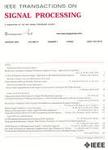版权所有:内蒙古大学图书馆 技术提供:维普资讯• 智图
内蒙古自治区呼和浩特市赛罕区大学西街235号 邮编: 010021

作者机构:Univ Illinois Coordinated Sci Lab Urbana IL 61801 USA
出 版 物:《IEEE TRANSACTIONS ON SIGNAL PROCESSING》 (IEEE Trans Signal Process)
年 卷 期:1999年第47卷第10期
页 面:2821-2832页
核心收录:
基 金:National Science Foundation, NSF, (MIP-9623737) National Science Foundation, NSF Defense Advanced Research Projects Agency, DARPA, (DABT63-97-C-0025) Defense Advanced Research Projects Agency, DARPA
主 题:algorithm transforms equalizers low power reconfigurable subscriber loops
摘 要:In this paper, we present low-power reconfigurable adaptive equalizers derived via dynamic algorithm transforms (DAT s). The principle behind DAT is that conventional signal processing systems are designed for the worst case and are not energy-optimum on average. Therefore, significant energy savings can be achieved by optimally reconfiguring the hardware in these situations. Practical reconfiguration strategies for adaptive filters are-presented. These strategies are derived as a solution to an optimization problem. The optimization problem has energy as the objective function and a constraint on the algorithm performance (specifically the SNR), The DAT-based adaptive filter is employed as an equalizer for a 51.84 Mb/s very-high-speed digital subscriber loop (VDSL) over 24-pair BKMA cable. The channel nonstationarities are due to variations in cable length and number of far-end crosstalk (FEXT) interferers. For this application,:the traditional design is based on 1 kft cable length and 11 FEXT interferers. Tt was found that up to 81% energy savings can be achieved when cable length varies from 1-0.1 kft and the number of FEXT interferers varies from 11 to 4, On the average, 53% energy savings are achieved as compared with the conventional worst-case design.